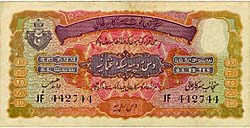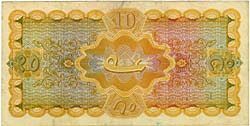|
The Princely State of Hyderabad was founded around 1724 when Mir Qamar-ud-Din, the
Mughal Viceroy of the Deccan, assumed independence under the title of Asaf Jah and
founded the dynasty of the Nizams of Hyderabad. In the post 1857 era, the state
of Hyderabad was one of the largest Princely States in India and later came to be
known as the 'Dominion of His Exalted Highness, the Nizam'. The State which covered
territories presently included in Andhra Pradesh, Maharashtra, and Karnataka was
assimilated into the Indian Union. In matters of currency and coinage, the coins
of the Nizams were issued in the name of the Mughal Emperor till 1858. Thereafter,
they were struck independently and the new coins were termed the 'Hali Sicca', i.e.,
the current coins. Where paper currency was concerned, the Government of Hyderabad
had made several state led efforts to organise private bankers and local 'saukars'
in the Dominion to set up a banking company which could issued paper money, amongst
other activities. These attempts to issue paper currency proved abortive, in the
wake of British resistance to Indian States issuing paper currency. The exigency
of the First World War, the Indian and Hyderabad contributions to British war effort,
and an acute shortage of silver on the subcontinent led the Dominion to get its
way in 1918 and paper currency was issued under the Hyderabad Currency Act. Notes
were issued in denominations of Rupees 100 and Rs 10. The currency was designated
the Osmania Sicca and the notes were printed by Messrs Waterlow and Sons. Rupee
One and Rupees Five notes were issued subsequently in 1919 and Rupees One Thousand
notes were issued in 1926. After the setting up of the India Currency Notes Press
at Nasik, Hyderabad notes came to be printed there for reasons of economy and security.
Hyderabad acceded to the Indian Union after police action. The Osmania Sicca was
demonetised in 1959. With the reorganisation of states on a linguistic basis the
State of Hyderabad ceased to exist.


Rupee Five Note (Obverse & Reverse)


Rupee Ten Note (Obverse & Reverse)
|